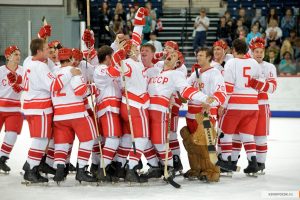By August Hagemann
On Tuesday, September 4th, Miami University’s Havighurst Center for Russian and Post-Soviet Studies kicked off its fall film series “Truth, Power, and Sport” with Legend No. 17. This 2013 Russian blockbuster tells the story of the star Soviet hockey player Valerii Kharlamov. The film centers on the first game of the Super Series, a 1972 series of 8 games to be played between the Soviet National Hockey Team and Canadian professional players, who were said to be the best players in the world. Despite this, the Soviet team emerges victorious. On September 11th, the Havighurst Center screened the second film of the series, Miracle (2004), which focuses on the United States’ 1980 Olympic hockey team, which would defeat the Soviet team in the gold medal round. Though these films feed into different national stories of triumph and victory, they are both founded on unexpected successes in the same sport from roughly the same time period. Both films are embedded with the same message about the relationship between national pride and sports — that is, that national pride can serve as an inspiration for athletic success, and that athletic success is a source of national pride.
The first part of this relationship is exemplified in both films by scenes depicting the rigors and stresses of preparing for the important competitions each film centers on. In both movies, in order to be successful and play as a team, players must abandon the rivalries they have developed over the course of their careers, and come together as a truly national team. In Miracle, the United States’ head coach regularly asks each player their name, their home town, and who they play for. The players typically answer the last question with the name of their university. This is a recurring theme, until after an exhibition game against the Norwegian National Team, when the players are being forced to skate up and down the rink after only managing to the tie the score. One player yells out his name, his hometown, and that he plays not for a college, but for the United States National Team. Legend No. 17 presents the realization of national unity in a very similar way — the Soviet head coach orders the players to skate in circles around him, calling out the names of the various high-level Soviet teams from which the players were drawn and ordering those players to stop, causing crashes. This finally stops when Kharlamov calls out to everyone that no one should stop skating, because they do not play for any of those teams anymore; they all play for the Soviet Union. Both of these scenes are indicative of a view that national unity feeds into athletic success, and that in some sense all the citizens of each country are one big team, who must overcome their differences and work together to be successful. Only by thinking of themselves as citizens of their country rather than by other traits or memberships do the players in either film manage to become a team. The importance of dedication to one’s country is further emphasized in both films in the way they depict players’ willingness to endure pain in order to play. In both films, learning to feel and overcome pain is an important part of the players’ training process. In Miracle this is shown as long, intense conditioning drills, while the coach in Legend No. 17 uses conditioning drills as well as more unorthodox techniques, such as having the players hit hockey pucks at each other as hard as they can while wearing only minimal protective gear. Both films also show players who courageously overcome the pain of injuries in order to continue playing. These scenes show that once the players have achieved consciousness of their status as players for their country, they are able to push beyond physical limitations, driven by their desire to bring honor to their nation.
This national pride and unity in both films links the teams together, and ultimately is responsible for their successes on the international stage. These successes in turn feed even more national pride, as the final victories in both films are depicted as things around which the entire country can gather and take pride in. A conversation in Miracle between the head and assistant coaches of the US team involves an acknowledgement that the United States has been bogged down by a negative news cycle, dominated by the Iranian hostage crisis and the malaise of the final years of the Carter administration. They discuss how important the success of the US team will be, as the people are more than ready for something positive to focus on. This same tendency is shown in Legend No. 17 during the game against the Canadians, where every major development in play is followed by multiple scenes of people from around the Soviet Union from every walk of life closely following the game, sharing in the stress, anticipation, and ultimate joy of the Soviet victory. Both of these scenes depict international athletic success as something that everyone in the country is involved in, and as something everyone should follow closely and take pride in. Far from being an end-goal, both films present these feats as openings to ever greater opportunity and inspiration.
In this way, both films create something of a positive feedback loop between international athletic success and national pride. These films reveal that sports are a part of both contemporary American and Russian identity as a source of glory and inspiration, and that in both cases success in sports is considered an indicator of the success of the country overall. These two films serve as an excellent beginning to the “Truth, Power, and Sport” series, establishing the notion that athletic successes form an integral part of national stories and identities.
August Hagemann is a junior majoring in Russian, East European, and Eurasian Studies.


